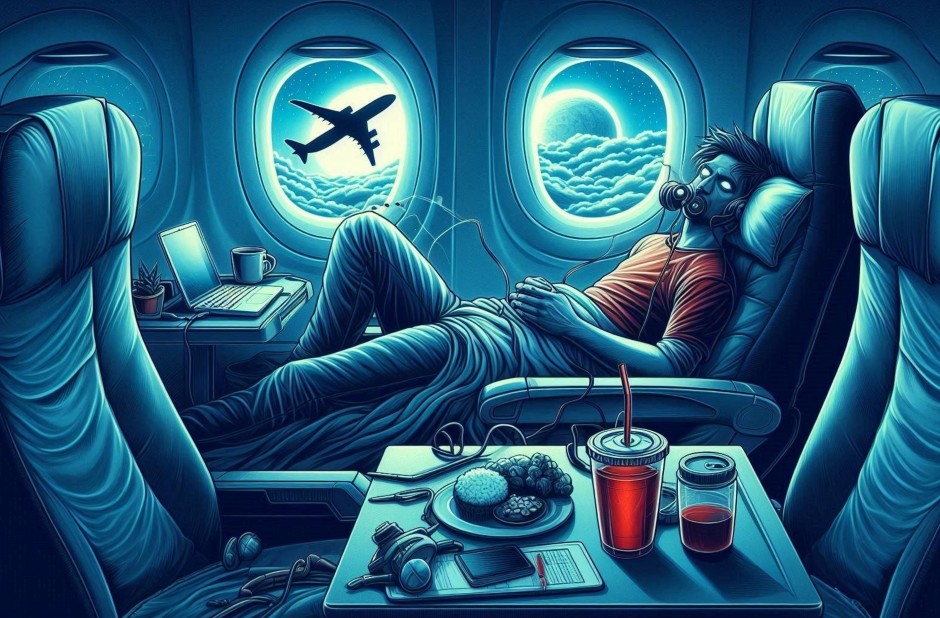Red-eye flights—those late-night departures that land early in the morning—can be a smart way to save time and money. These flights are especially popular with business travelers and those looking to maximize vacation days, as they allow you to travel overnight and wake up at your destination. However, without the right preparation, they can leave you feeling more like a zombie than a savvy traveler. The good news is that with a little planning, the right gear, and a few strategic choices, you can arrive at your destination feeling (almost) refreshed and ready to go. Here’s how to make red-eye travel more restful and less stressful.
Choose Your Seat Wisely
Your seat can significantly affect your ability to rest during a flight. Window seats are ideal for red-eyes because they give you a surface to lean against and control over the window shade, letting you avoid disruptions from other passengers. Conversely, aisle seats may offer easier access to the bathroom, but they often come with interruptions from seatmates or passing carts. Avoid seats near restrooms or the galley, which tend to be noisy, brightly lit, and full of foot traffic throughout the flight. If you have the option, consider upgrading to a seat with extra legroom or even splurging on premium economy or business class for a more restful experience. Even a small change in comfort can translate to much better rest during your journey.

Dress for Comfort
Comfort should be your top priority when dressing for a red-eye. Forget fashion-forward looks and instead opt for cozy, breathable layers. Airplane cabins can be unpredictable in terms of temperature—sometimes chilly, sometimes stuffy—so it’s best to wear a hoodie, lightweight sweater, or jacket that you can easily add or remove. Choose fabrics that are soft and stretchy, like cotton or bamboo blends, and avoid anything too tight or constricting. Slip-on shoes make navigating airport security faster and more convenient, and warm socks can help keep you comfortable once you’re settled into your seat. The right outfit can ease your transition into sleep and help you wake up feeling more relaxed.
Bring Sleep Essentials
The right gear can turn an uncomfortable airplane seat into a semi-decent place to sleep. A supportive neck pillow is key—look for one that cradles your head and doesn’t force your neck into an unnatural position. An eye mask can block out cabin lights, which are often on longer than you’d expect, and noise-canceling headphones or earplugs can drown out chatty neighbors, engine hum, or crew announcements. Some travelers also pack a travel blanket or oversized scarf for added warmth. If you have trouble sleeping in unfamiliar environments, consider bringing melatonin or another gentle sleep aid, but always test it at home first to ensure you don’t experience unwanted side effects mid-flight. Creating a sleep-friendly setup is one of the best ways to survive—and thrive—on a red-eye.
Avoid Stimulants and Alcohol
While it may be tempting to have a glass of wine or coffee before your flight, both alcohol and caffeine can negatively impact your ability to get quality rest. Alcohol may make you feel drowsy at first, but it can lead to fragmented sleep and dehydration, leaving you groggy upon arrival. Caffeine, obviously, is a stimulant that can interfere with your natural sleep cycle, even if consumed several hours before bedtime. Instead, opt for water or herbal tea to stay hydrated and promote relaxation. Staying properly hydrated not only supports better sleep, but also helps you recover more quickly from the physical stress of flying. Avoiding these common culprits is a simple but effective strategy to ensure your red-eye doesn’t leave you drained.
Adjust Your Internal Clock
If your red-eye flight involves a time zone change, try gradually adjusting your sleep schedule a few days before departure. Going to bed and waking up slightly earlier or later can help ease the transition and reduce the intensity of jet lag. On the plane, do your best to align with your destination’s time zone by eating, sleeping, and adjusting your internal expectations accordingly. This mental preparation can make a big difference when it comes to feeling alert and oriented after landing. Apps like Timeshifter or simple calendar reminders can help you create a plan in advance. A little proactive time management before your trip goes a long way in making overnight travel less taxing on your body and mind.

Eat Light Before You Fly
A heavy meal right before boarding can leave you feeling bloated and uncomfortable during your flight, especially when your goal is to sleep. Instead, opt for a light, balanced meal a couple of hours before takeoff. Focus on easily digestible foods like lean proteins, vegetables, and whole grains. Skip anything overly greasy, salty, or sugary, which can lead to discomfort or disrupt your rest. If you plan to eat during the flight, check the airline menu in advance or bring your own healthy snacks. Nutritious, easy-to-pack options like trail mix, fruit, or whole grain crackers can keep hunger at bay without upsetting your stomach. What you eat has a direct impact on how you sleep, especially in transit.
Use the Airport to Wind Down
Airports can be hectic places, but they also offer opportunities to ease into your flight mentally and physically. Instead of rushing from gate to gate or checking emails until the last second, give yourself time to decompress. Take a walk to help circulation, especially if you'll be seated for several hours. Listen to calming music, read something light, or do a short meditation. Some airports now offer dedicated wellness zones or yoga rooms where you can stretch and relax. Use the downtime to reset, reduce anxiety, and prepare for sleep so that you're not overstimulated when boarding. Treating your airport experience as part of your wind-down routine can significantly improve your rest in the air.
Sleep Strategically
Once on board, prioritize sleep right away. After takeoff, recline your seat as soon as it’s allowed, get your sleep gear in place, and settle in. Avoid turning on the in-flight entertainment if you know it’ll keep you awake longer than intended. Set a sleep timer on any music or apps you use, and try to sleep in uninterrupted stretches, even if it’s just for two or three hours. Any consistent rest is better than sporadic dozing. Minimize movement and screen time, and let your body relax completely. Even partial sleep on a red-eye can be restorative enough to help you feel balanced the next day, especially if you supplement it with natural light and rest upon arrival.

Freshen Up After Landing
When the flight ends, take a few minutes to refresh yourself before starting your day. A quick visit to the restroom to wash your face, brush your teeth, and change clothes can make a huge psychological difference. Having a small toiletry kit with essentials like facial wipes, mouthwash, deodorant, and moisturizer can help you feel human again after hours of travel. If your schedule allows, take a short nap or shower at your hotel before diving into any major activities. These little acts of self-care signal to your brain that the flight is over and it’s time to reset. Even a modest amount of freshening up can help you hit the ground running, whether you’re heading to a meeting or straight to sightseeing.
Plan Your First Day
Don’t overstuff your arrival day with activities. Give your body and mind time to adjust to the new surroundings and catch up on any sleep you missed. Get outside for some natural light exposure, eat a healthy meal, and try to stay awake until a reasonable local bedtime to help reset your circadian rhythm. If you need to rest during the day, limit naps to 30 minutes to avoid grogginess or difficulty falling asleep later. Planning your first day with flexibility in mind allows you to recover gracefully from the flight and enjoy the rest of your trip more fully. The way you start your journey sets the tone for everything that follows.
Conclusion
Red-eye flights don’t have to be a necessary evil. With the right mindset, smart packing, and healthy habits, you can turn an overnight journey into a productive and even restful part of your travel itinerary. From selecting the right seat and dressing comfortably to managing your sleep and hydration, each small step contributes to a smoother flight experience. The next time you see that tempting late-night departure, don’t shy away—just prepare accordingly and embrace the benefits of smarter, more strategic flying.
